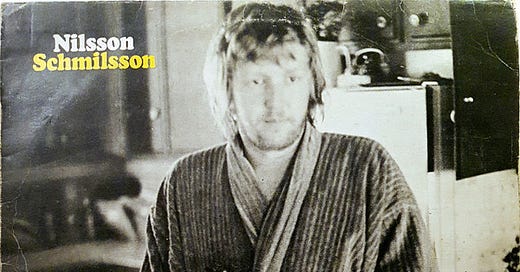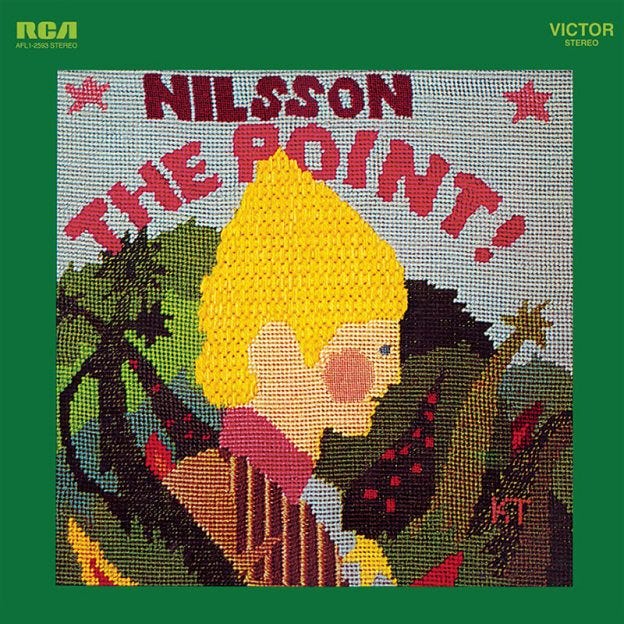“One is the loneliest number that you'll ever do”
“Goin’ where the weather suits my clothes”
“Put the lime in the coconut, and drink it all up”
“Can’t live, if living is without you”
“You can jump into the fire but you’ll never be free”
I would bet that if you are like me, as you read these lyrics, the melody would immediately spill into your head.
Those are just a few of the many iconic lyrics written or made popular by Harry Edward Nilsson III, better known as Nilsson. He was born in Brooklyn in 1941 but moved to Los Angeles as a teenager. At the age of 3, his father abandoned his family. He was raised by his mother and a younger half-sister.
By 1962, Nilsson was taking singing lessons supported by his uncle and beginning to write songs. One composition ended up in the hands of Little Richard. When he heard Nilsson’s voice on it, he remarked, "My! You sing good for a white boy!"
By 1964, he was co-writing with “Wall of Sound” producer Phil Spector. Eventually, a friend and fellow musician named George Tipton invested his life savings to record and produce 4 Nilsson songs. These ended up on his debut album, Spotlight on Nilsson, released in 1966.
Nilsson’s second album, Pandemonium Shadow Show, was the first in his 3-record deal with RCA and was given the full studio treatment. On it, he chose to cover two Beatles songs, “She’s Leaving Home” and “You Can’t Do That.” On the latter song, he mashed up lyrics from 17 other Beatles songs. Although the album barely charted in the US, it got someone’s attention in the UK. The Beatles’ publicist heard the album on his car radio and was so impressed, sent copies of the album to each of the band members.
Later, in an interview with John Lennon in 1968, he was lamenting about the state of American music when he said, "Nilsson is my favorite group," clearly not understanding it was a solo performer and not a band. When Lennon discovered Nilsson was a person, he proclaimed “Nilsson for President” (Richard Nixon was elected 37th US President that year). Both Lennon and McCartney called Nilsson to praise the work he did on Pandemonium. (Imagine getting a long-distance call from John or Paul in those days!)
Nilsson finally scored his first minor hit in the US with a cover of Fred Neil’s “Everybody’s Talkin’,” from his third album: Aerial Ballet. One year later, the song was used in the film Midnight Cowboy which earned Nilsson his first Grammy and first top ten hit.
(Fred Neil was a folk singer/songwriter in the sixties who never earned much recognition except from the artists who covered his work. Fred would achieve his dream of “goin’ where the sun keeps shining” in Summerland Key, FL where he would pass away from cancer in 2001). For more on Fred, check out http://www.furious.com/perfect/folkniks.html
Aerial Ballet would also feature the song, “One” which became a top 5 hit by Three Dog Night on their first album released in 1968. Nilsson got his inspiration for “One” when he dialed a number on his phone and got a busy signal. For those of us old enough to remember, go ahead and play the opening riff and imagine the sound of a busy signal.
Nilsson’s next album, Harry, contained a companion piece to “Everybody’s Talkin’” for Midnight Cowboy employing a similar ambling melody and structure: “I Guess the Lord Must Be in New York City." Although not used in the film, it was much later featured on the soundtrack to You’ve Got Mail.
Nilsson became an early fan of the then-unknown Randy Newman. After covering one of his songs on Harry, he then devoted his next entire album to Newman songs. Called appropriately, Nilsson Sings Newman, it was commercially unsuccessful just as his name was beginning to be recognized.
His next project was a themed album, The Point!, that was accompanied by an animated film adapted from Nilsson’s fable about a boy born with the only round head in the Pointed Village where by law, everyone and everything needed to have a point.
This album is the only one of Nilsson’s in my collection. The animated film was broadcast on ABC in 1971. As a junior in high school, I was the perfect age for its irreverent, mind-bending, playful puns…”You have been found guilty of being pointless!” … “There’s no point in the pointless forest for you” …”A point in every direction is the same as no point at all….” The record album also contains a short comic book illustrating the story. Unlike the animated film, on the album Nilsson narrates the story and voices all the characters. The theme song, “Me and My Arrow” even became a hit in 1971.
Later that same year, Nilsson would go to England to record his career-defining album, Nilsson Schmilsson. He and his producer, Richard Perry, wanted to make as close to a Beatles-quality album as possible. Featuring a cover of Apple Records’ artist, Badfinger’s “Without You,” which today sounds like a schmaltzy, sugary pop song, it was countered with the raucous howler “Jump into the Fire.” The latter had numerous reboots, most notably on the soundtrack of Scorcese’s gangster film Goodfellas. (Jim Gordon of Derek and the Dominos plays the drum solo)
This album also produced the novelty song, “Coconut” – another in a series of tunes you just can’t get out of your head once you hear it (sorry). Maybe it was the Muppets version that cemented it into our brains. But even more earwiggy is the tune that kicked off side one: “Gotta Get Up.” Anyone who watched the series Russian Doll knows what I’m talking about. It feels like the grown-up version of “Wake up Little Susie”: “Gotta get up, gotta get out, gotta get home before the morning comes.”
His follow-up album (ironically named Son of Schmilsson) was released just 8 months after Nilsson Schmilsson which was still pushing out singles. Other than “Spaceman” there were no commercially successful songs and his lyrics turned dark due to an impending divorce, and quite bawdy: "I sang my balls off for you, baby." On top of this, even at the height of his career, he refused to tour. His producer, Richard Perry was quoted saying, “At some point, the public needs to reach out and touch the artist, experience and feel them in person.” Composer friend, Perry Botkin said, “He was terrified to do a live performance.”
After Son of Schmilsson, he decided he no longer needed Perry as producer. His next album featured covers of pop standards from the 50s and 60s, something that today is trendy but in the 70s, was not cool. During this time, while John Lennon was on his 18-month separation from Yoko Ono, he got back together with his friend Nilsson. But other than briefly reuniting with Paul McCartney for a jam session, this period was not a creative one. It became known as Lennon’s “lost weekend,” when he and Nilsson joined other buddies in the “Hollywood Vampires” drinking club. Members also included Keith Moon, Alice Cooper, Ringo Starr, and Micky Dolenz (Monkees). Drinking and drugs were on the menu and so was erratic behavior like getting booted from the Troubadour in LA after heckling the Smothers Brothers. Ringo would later be Harry’s best man at his third wedding.
Harry’s relationship with John Lennon only intensified when John produced Nilsson’s next album, Pussy Cats. As suggested in the 2010 documentary film about Nilsson, Who is Harry Nilsson?, both John and Harry were dealing with failed relationships and it crept into the recordings. He irreparably damaged his vocal cords trying to primal scream his way through a Dylan song.
A victim of bad timing and bad luck, Nilsson released what he called his favorite album, Knnillsson, in 1977 just as we read the news of Elvis Presley’s death. RCA used all their marketing capital to push Elvis’s back catalog instead of promoting Nilsson’s new album.
If that wasn’t enough, tragedy seemed to follow in Nilsson’s path, through no fault of his own. Singer Cass Elliott, going solo after The Mamas and the Papas split, often stayed at Nilsson’s London apartment when he was in the US. After a 24-hour celebration following a successful run at London’s Palladium in July 1974, she was found dead in one of Nilsson’s bedrooms. Four years later, friend and Hollywood Vampire club member, Keith Moon, returned to the same bedroom and was found dead from an overdose of Clomethiazole (used to treat alcohol withdrawal). Both died at age 32. Nilsson sold the flat soon after.
Then, in 1980, the unthinkable happened. John Lennon was shot at the entrance to his home at the Dakota in New York City. Nilsson was never quite the same after that. He devoted much of his energy to ending handgun violence. For someone who rarely was in front of the public, he threw himself into this effort, lobbying in Washington, organizing, and doing public service announcements. He recorded sporadically for the next 13 years.
In 1991, Harry discovered that his financial advisor had been embezzling money from his recording royalties. "We went to bed one night a financially secure family of eight and woke up the next morning with $300 in our checking account," Nilsson wrote in a letter filed in court. After surviving a heart attack in 1993, he began working on a box-set anthology of his career but before it was finished, he died of heart failure in 1994 at age 52.
Nilsson’s lyrics defined him. And these from “Gotta Get Up,” written when he was thirty, seemed to foretell his future:
There was a time when we could dance until a quarter to ten,
We never thought it would end then, we never thought it would end,
We used to carry on and drink and do the rock and roll,
We never thought we’d get older,
We never thought it’d grow cold
References:
https://archive.seattletimes.com/archive/?date=19941107&slug=1940340
https://www.grunge.com/314496/the-tragic-story-of-harry-nilsson-the-beatles-favorite-group/
https://en.wikipedia.org/wiki/Harry_Nilsson
Documentary: Who is Harry Nilsson (And Why is Everybody Talkin’ About Him?) https://www.imdb.com/title/tt0756727/





What an enjoyable 40 mins reading, listening to the narrative and songs you pulled together here Pete! What a range!
Nice as always Pete. I know his music but did not know about his hard-charging lifestyle or connections.